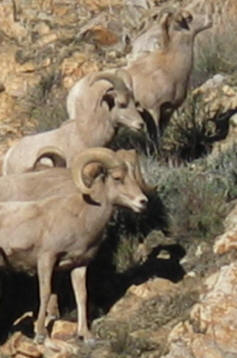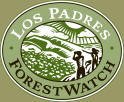|
DESERT
BIGHORN SHEEP
Ovis
canadensis nelsoni
Bighorn sheep,
named for the massive curved horns worn by the
males, range throughout the
western United States, with
 populations
found from Mexico to Canada. The species is divided into three
distinct subspecies—Rocky Mountain bighorn sheep (Ovis
canadensis canadensis), desert bighorn sheep (Ovis
canadensis nelsoni), and Sierra Nevada bighorn sheep (Ovis
canadensis sierrae)—two of which, desert bighorn and Sierra
Nevada bighorn, are found here in California. The Los Padres
National Forest represents the western extent of desert
bighorns, but they were eliminated from the area in the early
1900s. A small population of bighorns were reintroduced to the
Sespe Wilderness in the 1980s where they can still be found
today, clambering down steep rocky cliffs. populations
found from Mexico to Canada. The species is divided into three
distinct subspecies—Rocky Mountain bighorn sheep (Ovis
canadensis canadensis), desert bighorn sheep (Ovis
canadensis nelsoni), and Sierra Nevada bighorn sheep (Ovis
canadensis sierrae)—two of which, desert bighorn and Sierra
Nevada bighorn, are found here in California. The Los Padres
National Forest represents the western extent of desert
bighorns, but they were eliminated from the area in the early
1900s. A small population of bighorns were reintroduced to the
Sespe Wilderness in the 1980s where they can still be found
today, clambering down steep rocky cliffs.
Nature's Original Rock
Climbers
Bighorn sheep are nature’s
original rock climbers – they require rugged, rocky habitat,
which they climb easily due to soft hooves that stick to almost
anything. On these cliffs, ridges, and rocky slopes the sheep
forage on grasses and shrubs, mate, and give birth to their
young, which from birth can negotiate the cliffs almost as well
as their parents. The sheep also use the steep terrain as a way
to escape from predators, most of which cannot follow them.
Slopes steeper than 80% provide the best “escape terrain” for
the sheep. In addition to their uncanny ability to scamper up
vertical cliffs, the desert bighorn is also so adapted to its
dry environment that it can go lengthy periods without drinking
water.

Bighorn sheep are very social
animals, and females (ewes) form herds of 5-15 consisting of
ewes and lambs up to two-years of age, lead by a dominant
female. Rams likewise form herds or “bands,” which consist
solely of 2-5 rams. Mating season begins in the fall, during
which time rams have “butting” contests, in which they charge
each other at speeds greater than 20 miles per hour—the crack of
which can be heard more than a mile away. The sheep then breed
through early winter and give birth to one lamb, or sometimes
twins, in April to late June on the most highly inaccessible
cliffs, away from predators. The sheep live about 15 years, and
are preyed on by wolves, mountain lions, golden eagles (which
attack only lambs), coyotes, bears, and even bobcats.
The Decline of Bighorn
Bighorn sheep were once
abundant throughout California and much of the west, with some
total population estimates as high as 2 million; however, their
populations have declined dramatically throughout their range
over the last century. Today, two populations—Sierra Nevada
bighorn sheep, and peninsular bighorn sheep (a population
segment of the desert bighorn sheep)—are listed as “endangered”
under the federal Endangered Species Act, having declined to
populations as low as one hundred animals. All bighorns are
living in increasingly fragmented populations, which biologists
fear could increase their risk of extinction, as a single event
could wipe out a population. Primary causes for the decline of
bighorn sheep include habitat alteration from development,
road-building, and other land uses, as well as hunting and the
spread of diseases passed to them by domestic sheep. Predation
by mountain lions is also problematic for bighorns as mountain
lion populations increase across California.
Bringing Back the Bighorn to the Los Padres
In the Los Padres, the western
extent of the desert bighorn’s range, hunting and disease
pressures led to extirpation of the bighorn in our region by
1914. Recognizing their importance, however, the California
Department of Fish and Game (CDFG), in 1985, decided to make a
bold attempt at restoring the desert bighorn to the Los Padres.
They started the reintroduction program with a transplant of 37
desert bighorn sheep from a population in the San Gabriel
Mountains to the Sespe Wilderness. The original transplant did
not go quite as planned, however, as the helicopters encountered
strong winds, which lead to a scattered release of the animals.
As bighorn sheep are naturally social and prefer to roam in
herds, their scattered release, in addition to their general
unfamiliarity with the terrain, left them vulnerable to
predators and a number of the sheep were lost almost
immediately.
The released population stabilized within a few years, but by
the early 1990s biologists were only able to locate a couple of
the sheep and CDFG decided to stop looking and give up on any
form of management of the reintroduced bighorns. At the same
time, many of the other sheep populations in the state were
likewise struggling, including the source population for the
reintroduction, the San Gabriel Mountains. This made any
continued transplants of the bighorns to the Los Padres
impossible. Any sheep that survived in the Sespe Wilderness were
going to have to fend for themselves.

The Sespe sheep did just that
and more. By 1999, hikers, hunters, and other adventurers
started reporting sheep again, and CDFG restarted their
monitoring program. Then came the 2006 Day Fire, and fears that
again the Sespe bighorns might be lost. But to everyone’s
surprise, many bighorns survived—at least 28, which were sighted
by biologists—and were seen roaming through the scorched
landscape left by the fire. As it turns out the fire may
actually have benefited the sheep, as it opened up a lot of
their habitat. Bighorn sheep depend on being able to see great
distances in order to avoid predators, so fire, which creates a
natural mosaic of open and vegetated habitats, may enable the
Sespe bighorns to further increase their population.
Biologists continue to closely monitor this population closely.
The original goal of the reintroduction program was to reach a
hundred sheep in the Sespe Wilderness, and this population may
still be a ways off. Additionally, no one knows what impact
recreation in the Sespe Wilderness is having or will have on the
bighorns. Though the Sespe Wilderness, contrary to other bighorn
habitat in Southern California, is fairly remote and protected
from future development, it still gets a number of visitors each
year in the form of hikers, fishers, hunters, horseback riders,
etc., and thus ample opportunity for conflict with bighorns.
Scientists have found that bighorns can be very sensitive to
human presence, and even the slightest disturbance can set them
off to less suitable habitat or lower quality food sources,
resulting in a decrease in their overall health.
For now though, the Sespe bighorns seems to be doing alright.
Good luck finding them though; they are very elusive and will
probably see you coming long before you even know they’re there.
|

